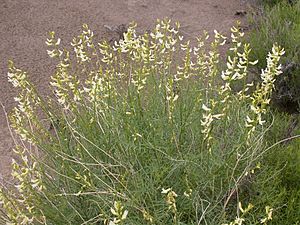Basalt milkvetch facts for kids
Quick facts for kids Basalt milkvetch |
|
|---|---|
 |
|
| Scientific classification |
The Astragalus filipes, commonly called Basalt milkvetch, is a type of wild plant. It belongs to a large group of plants known as milkvetch. This plant grows naturally in western North America. You can find it from British Columbia in Canada, all the way down to California in the United States, and as far east as Utah. It likes to grow in many different places, especially dry areas.
What it Looks Like
The Basalt milkvetch is a plant that grows back year after year. It forms clumps and can reach a height of about 30 to 90 centimeters (about 1 to 3 feet) tall.
Leaves and Flowers
Its leaves can be up to 12 centimeters long. Each leaf is made up of several small, thin leaflets. These leaflets are spaced out and can be shaped like a line or a small oval.
The plant produces groups of flowers called an inflorescence. Each group can hold up to 30 flowers. The flowers are usually off-white or a pale yellow color. They are about 1 to 1.5 centimeters long.
Fruit Pods
After the flowers, the plant grows a fruit called a legume pod. These pods hang down and can be up to 3 centimeters long. They are long and thin. When they dry, they become very light and feel like paper.
See also
 In Spanish: Astragalus filipes para niños
In Spanish: Astragalus filipes para niños

